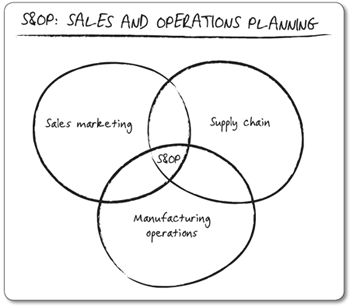S&OP process is backbone of a supply chain. It brings together the demand and supply components to enable advance planning for smooth functioning of supply chain. It all began sometime back when it was realized that independent isolated departmental plans can not be continued to attain efficiency. And thus the need for a consensus plan became apparent for which all the silos of the enterprise must be united to execute an agreed upon strategy.
Nowadays the interest in S&OP activities has surged due to evident benefits achieved by leading companies including increased forecast accuracies, reduced inventories, waste, costs and planning efforts. Qualitatively companies have achieved business alignment between the functional units, increased supply chain visibility and improved customer satisfaction due to harmonization between demand, supply and finances. These reasons are not the only ones which have led to surge in S&OP activities in industry. Those are only the advantages, while the actual reason is cut-throat competition, increased demand volatility and shorter product lifecycles.
Ideally S&OP process is done proactively with sales, marketing, and operations team allocating constrained products to customer orders, expediting product shipments or reconfiguring products to create the required models. The process is better depicted below which resembles to Kaplan's balanced scorecard (sales & marketting representating customer and operations representing internal processes):
The basic elements of the S&OP process are the stakeholders, which must include Sales, Marketting and Operations departments of the organization. Nowadays to align S&OP process to IBP process (Integrated Business Planning), the Finance department has got also deeply involved in S&OP processes the main indicator of success is bottom line. In layman's term, each of these departments come pre-prepared for S&OP with agenda of their own and brings forward their concerns on the table in the form of metrics, KPIs and objectives. For instance, Marketing department might present the budget of the present year and corresponding allocation for the next 3 months while at the same time Operations department might present constraints on the existing capacities or logistics concerns, and sales might display outstanding customer orders for next 1-2 months. The data presented by each of the department is usually presented at different levels such as organizational level, brand specific level, product level, and even SKU level. Thus pre-planning of a S&OP becomes an exhaustive excersize.
Different consulting and IT organizations might have redefined S&OP process, metrics, steps, frequency, but most of those have been mere marketing gimics providing limited differentiation to the actual output of the process which is finalized production and distribution plan.
**Sometimes S&OP process might also lead to reconsidiration of adding capacity in future or identification of sub-contractors for additional capacity.
Nowadays the interest in S&OP activities has surged due to evident benefits achieved by leading companies including increased forecast accuracies, reduced inventories, waste, costs and planning efforts. Qualitatively companies have achieved business alignment between the functional units, increased supply chain visibility and improved customer satisfaction due to harmonization between demand, supply and finances. These reasons are not the only ones which have led to surge in S&OP activities in industry. Those are only the advantages, while the actual reason is cut-throat competition, increased demand volatility and shorter product lifecycles.
Ideally S&OP process is done proactively with sales, marketing, and operations team allocating constrained products to customer orders, expediting product shipments or reconfiguring products to create the required models. The process is better depicted below which resembles to Kaplan's balanced scorecard (sales & marketting representating customer and operations representing internal processes):
Different consulting and IT organizations might have redefined S&OP process, metrics, steps, frequency, but most of those have been mere marketing gimics providing limited differentiation to the actual output of the process which is finalized production and distribution plan.
**Sometimes S&OP process might also lead to reconsidiration of adding capacity in future or identification of sub-contractors for additional capacity.






 Posted in:
Posted in: 

